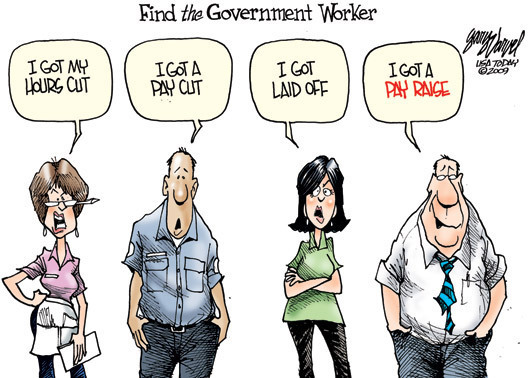|
Last week, the co-chairs of
the Joint
Ways and Means Committee released
their budget
framework. Their
budget claims to address the reality that, ďwe must
grapple with the fact that Oregon is facing a $1.8
billion budget shortfall in the coming biennium.Ē
But, it falls short of a successful take-down and
there really is no serious grappling going on here.
Grappling would involve something more real, sweaty
and contentious. It would be a battle where serious
issues were actually addressed. ďGrappleĒ is a
high-energy, action word where one would expect to
see significant headway when it comes to dealing
with Oregonís currently unsustainable trajectory.
It appears that the co-chairs donít realize that
Oregon has been in a tepid and barely measurable
economic recovery. Our economy is one of the weakest
in history in terms of job growth, although revenue
is flowing into the stateís coffers. If we fall into
another recession, the PERS unfunded liabilities
will necessarily sky-rocket leaving Oregon with no
tools or dry powder left.
At least the co-chairs have come to realize that
Governor Brownís budget has problems. Yet, they
insist on classifying the problem as being a $1.8B
shortfall.
This is not true. There is no shortfall.
Even with our tepid economic
growth there is more revenue pouring into Oregonís
treasury than ever before. Never in Oregonís history
has so much money been available for government
services. The truth is our current biennium is
expected to gain $3.1B more revenue than the
previous biennium largely due to rising
marginal tax rates and the economically destructive bracket
creep across
all income levels.
Our real problem is that government growth has
outpaced revenue growth by the $1.8B shortfall.
Clearly, this calls for a different mind-set when it
comes to wrestling with Oregonís sustainability.
Oregon's problem is a spending problem.
Not only are we spending more than we receive from
local taxpayers but nearly forty-cents ($.40) of
every dollar ($1.00) spent by Oregon comes directly
from federal funding sources. This means that 4 out
of every 10 teachers is funded by the federal
government. It also means, 4 out of every 10 state
troopers, DEQ staff persons, university employees,
parks & recreation staff, road department personnel,
DHS staff, DAS personnel and more, is funded by
federal dollars.
Now, in discussion, you might be told, this is not
true because federal monies are typically silo-ed
into specific areas like infrastructure, highways,
criminal justice, prison systems and grants for
employees, research projects and studies.
However, this masks what is going on. You see, if
Oregon can save a dollar on infrastructure by using
Uncle Samís dollar instead, then the dollar saved by
Oregon can get shifted toward other services or
personnel. Hence nearly 40% of Oregonís entire
budget, meaning all services, projects and
expenditures comes from federal funding. This is
clearly unsustainable.
Why?
The answer is it all comes from the same place Ė the
taxpayerís pocket


Governments, just like people, come into the world
naked and poor. People either inherit resources or
create money through hard work. In the private
sector we see this occurring through competition,
innovation, and invention. For government, the
citizens with their ingenuity and wealth creation
are the only source at hand.
What we are witnessing today, in the public sphere,
is a cavalier attitude toward this ultimate source
of wealth. The co-chairs budget statement even
attempts to shift blame onto the backs of citizens
for daring to prefer a smaller government that might
actually live within itís means.
The co-chairs belittle Oregonís citizens for
adopting Measure 5, by voter approval in 1990.
Measure 5 reduced property taxes while shifting the
responsibility for funding K-12 schools from local
property taxes to the state general fund. This was a
perfectly legitimate request from the citizens
regarding how their money was to be allocated and
spent. Voters also passed Measure 50 which limited
funding on local tax levies.
Besides unfunded PERS
liabilities at $22 Billion, our Oregon
debt load is $37.5 Billion,
or about $9,300 for every man, women and child in
the state. Unfortunately newborns and five-year-olds
arenít paying any taxes so someone else is on the
hook for their share.
Now, while Iíve got you
thinking about debt, add-in your city's debt and
unfunded liabilities, your county's debt and
unfunded liabilities, your mortgage, your credit
card, auto and student loan debt and then top it off
with your share
of the federal debt ($20
Trillion) or, ~$61,000 per person.
There is only one way out. Prudence and wisdom
dictate that we cannot continue to spend like debt
is an economic elixir.
Voters passed Measure 5 and 50; they rejected
Measure 97; their wishes need to be heard and
respected. We must learn to be frugal Ė itís our
only hope.
Remember, if we don't
stand for rural Oregon values and common-sense
Ė No one will!
Best regards,
Dennis Linthicum
Oregon State Senate 28
Capitol Phone: 503-986-1728
Capitol Address: 900
Court St. NE, S-305, Salem, Oregon 97301
Email: sen.DennisLinthicum@oregonlegislature.gov
Website: http://www.oregonlegislature.gov/linthicum
====================================================
In accordance with Title 17 U.S.C.
section 107, any copyrighted material
herein is distributed without profit or
payment to those who have expressed a
prior interest in receiving this
information for non-profit research and
educational purposes only. For more
information go to:
http://www.law.cornell.edu/uscode/17/107.shtml |

